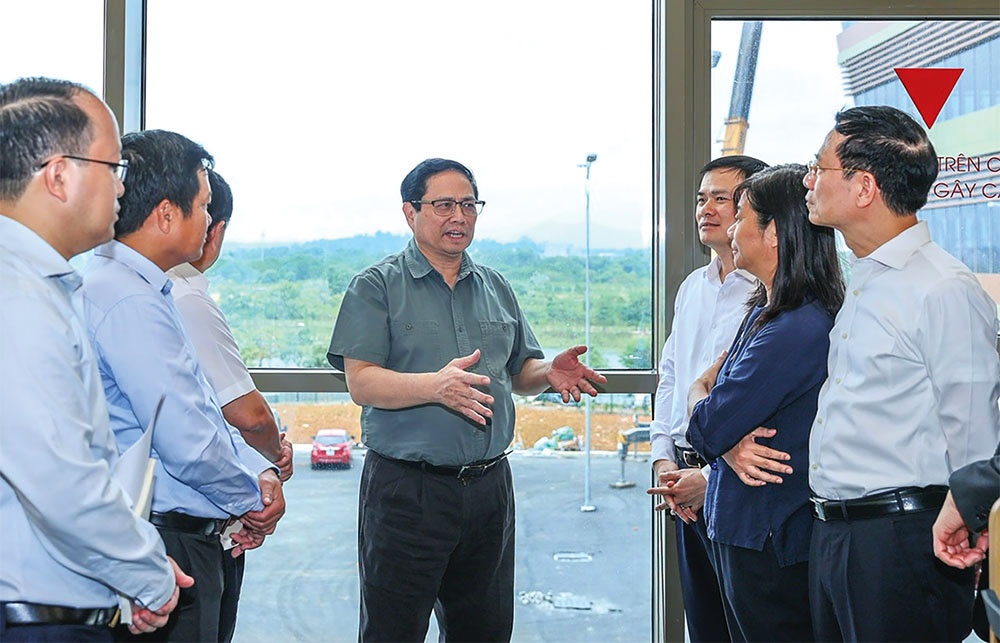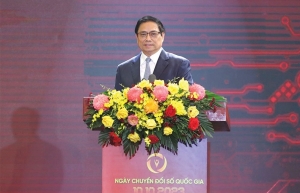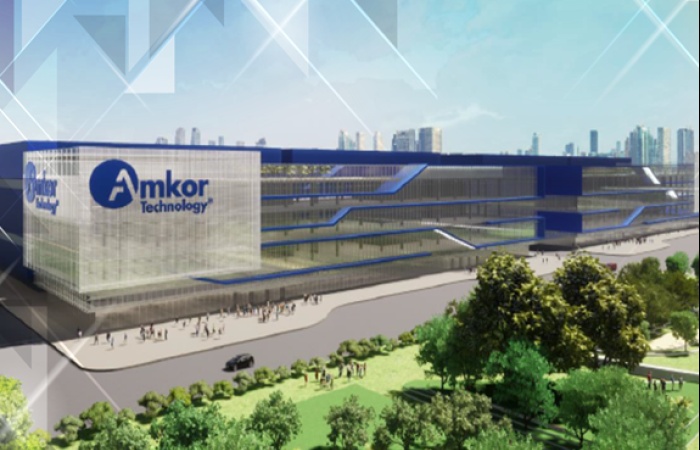Legal barriers still shackling innovation developments
 |
| PM Pham Minh Chinh gives directions on the functions and tasks of the National Innovation Centre, Photo: Nhat Bac |
In the recent 2023 Global Innovation Index (GII), Vietnam ranked 46th among 132 listed countries and economies, up two places from 2022. The index, created by the World Intellectual Property Organization, also lists Vietnam as one of the top seven middle-income countries showing the most progress in innovation over the last decade.
Vietnam’s dynamic innovation ecosystem is thanks to the rapid development of its digital economy and its strong growth in the technology sector. In the GII, Vietnam’s main innovation strengths are listed as high-tech exports and imports, as well as labour growth.
This is reflected by the country’s position at 57th in terms of the innovation input sub-index and 40th in the innovation output sub-index, both marginal improvements on last year. However, the GII also noted a poor performance in institutional indicators.
One example is Sky Mavis, a startup that became a unicorn within three years and eight months, and is valued at $3 billion. The company was founded and is managed by Vietnamese, but its offices are located in Singapore.
“In Singapore, legal frameworks for overseas enterprises are better and easier, especially in transferring capital overseas. If we expand operations and markets to other countries, Vietnam’s regulations are too difficult. That is why a lot of technology startups have chosen Singapore as a destination,” Nguyen Thanh Trung, founder of Sky Mavis said.
In addition to Sky Mavis, numerous technology and innovation firms have already started their business in Singapore, including DotGears Co., Ltd. – the company behind the breakout game Flappy Bird, among others.
“Amid the increasing competition among countries, a clear and up-to-date business environment is the most important factor,” said Le Han Tue Lam, general partner of Nextrans.
“If businesses cannot open up new markets or cannot find new ways to expand from the Vietnamese market, they will surely not choose Vietnam as a destination. How long does it take to build a more attractive policy and institutional framework? Investors can wait for a few years, but 10-20 years will be too long for their patience, and they will opt out of Vietnam,” he questioned.
Cao Anh Tuan, CEO of Genetica, a leading gene decoding centre, agreed that it is easier for companies located in overseas countries to mobilise capital, and investors often look at that country to count the number of unicorns, to understand the mechanism for investing and withdrawing capital, and how much the profit rate is.
“In Singapore and the United States, there are specific examples of businesses boasting huge profits, many thousands of times higher if a startup is successful, but in Vietnam, there are no such cases,” Tuan said.
In response to these roadblocks, policies calling for investment in innovation and incentives have been issued in recent years to the Law on Investment (2020) and the Law on Enterprises (2020), establishment and development of investment funds, small and medium-sized enterprises support fund.
“Additionally, the government has assigned the Ministry of Science and Technology to build new policies for technology and innovation firms, while the Ministry of Planning and Investment (MPI) is considering amendments to the decree on functions and tasks of the National Innovation Centre (NIC), including more effective policies to call for innovation in Vietnam,” said Minister of Planning and Investment Nguyen Chi Dung.
The NIC, an initiative of the MPI, started construction in 2021 at Hanoi’s Hoa Lac High-Tech Park, forming an innovation ecosystem with the three main pillars of the state - institutes - businesses, and connected to many international and local large corporations, R&D centres, 200 investment funds, and many Vietnamese experts and intellectuals around the world.
“We hope the NIC and its two headquarters on Ton That Thuyet street and at Hoa Lac High-Tech Park will become regional innovation hubs – high-class destinations of the innovation ecosystem,” Minister Dung said.
In particular, the Politburo has recently added innovation as a concept for Vietnam’s strategic strategy for the 2021-2025 period. The idea of innovation is also clarified in the country’s socioeconomic development direction and goals in all fields of society.
Promoting innovation and entrepreneurship is one of the key tasks stated in the government’s Resolution No.01/NQ-CP released early this year to strengthen socioeconomic development and improve national competitiveness by developing an innovation ecosystem. Ministries and agencies have proposed specific strategies and action programmes, formed numerous new production and business models and established various methods of mobilising resources for innovation.
“Seizing the opportunity of Industry 4.0 is a good chance for Vietnam to grow rapidly, catch up, and surpass, so it is necessary to realise this opportunity,” Minister Dung added.
Having seen the efforts of the Vietnamese government after a discussion with Minister Dung, in 2018, Cao Anh Tuan, who is CEO of Genetica, chose Vietnam as the location of the company after a lot of consideration.
“Our decision to base ourselves in Vietnam was our best decision ever. The youth in the Vietnamese workforce has contributed significantly to the success of Genetica in decoding the genes of not only Vietnam, but also regional economies such as Singapore, Taiwan, South Korea, and Indonesia. This is meaningful for human healthcare and treatment,” Tuan said, noting his appreciation for the support of the MPI and other Vietnamese ministries and agencies.
“With the current innovation ecosystem, I feel that Genetica does not go alone, we - the whole ecosystem - are going ahead together, educating and exploring the market together. We are delivering products and services to the market faster than ever, much faster than five years ago when we began,” Tuan said. He also placed plenty of expectations on the innovation ecosystem of Vietnam and called for more trust in other technology and innovation businesses.
In the US two weeks ago, the MPI and the NIC teamed up with American businesses and universities to create a leap forward in semiconductor manufacturing in Vietnam. What is more, they called for investment in new sectors like science-technology, digital transformation, green economy, and the circular economy.
 | New opportunities open for tech sector While Vietnamese technology companies are increasingly finding success abroad, new opportunities are giving way to innovations, as well as new tasks for ministries and agencies to collaborate effectively on data management in the months to come. |
 | Amkor opens mega factory for semiconductors in Vietnam On October 11, the US semiconductor product packaging and test services provider Amkor Technology opened a mega factory for semiconductor assembly and testing in the northern province of Bac Ninh. |
What the stars mean:
★ Poor ★ ★ Promising ★★★ Good ★★★★ Very good ★★★★★ Exceptional
Related Contents
Latest News
More News
- Human-centred governance seen as key to AI development (December 19, 2025 | 18:19)
- Top 10 notable events of Vietnam’s industry and trade sector in 2025 (December 19, 2025 | 14:00)
- Tungsten surges to 12-year high as world enters a new 'black gold' race (December 18, 2025 | 17:27)
- Vietnam’s coffee exports set new record despite price pressures (December 18, 2025 | 17:13)
- Garment and textile sector seeks new growth after volatile year (December 18, 2025 | 17:01)
- VinSpeed and Siemens strengthen cooperation for high-speed rail development (December 18, 2025 | 16:53)
- High-tech adoption for TH true MILK (December 18, 2025 | 13:39)
- Takeda supports health resilience amid climate change challenges (December 18, 2025 | 12:39)
- Mondelez Kinh Do - a chapter of purpose-led leadership in Vietnam (December 18, 2025 | 09:44)
- VNPAY services receive the highest-level PCI DSS international security certificates for six consecutive years (December 17, 2025 | 23:47)

 Tag:
Tag:




















 Mobile Version
Mobile Version